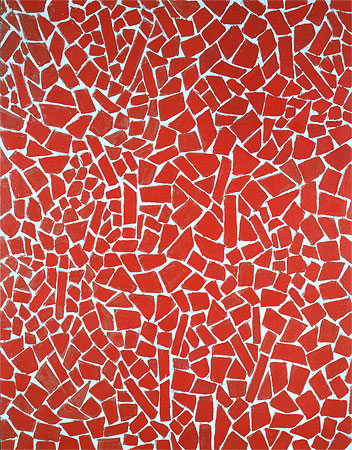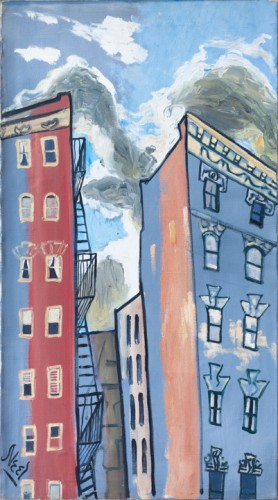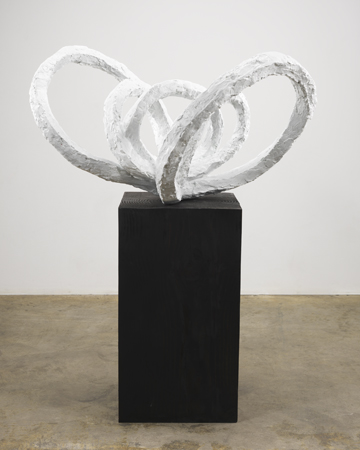I can’t review an exhibition in which my work is included, yet I would like to encourage people to see the exhibition To Be a Lady which has been extended through March 22nd and is particularly conveniently located for people coming to New York for the College Art Association conference next week, as it is installed in a public space a block down Avenue of the Americas from the Hilton Hotel, at 1285 Avenue of the Americas.

Alma Thomas (1891-1978), Red Scarlet Sage, 1976. Acrylic on canvas
46 x 36 inches, Courtesy of Michael Rosenfeld Gallery LLC, New York
I figure that since the show is divided into two parts, installed along two separate sections of the space, with one side featuring the works of women artists who are deceased, and the other side featuring those of us still among the living, I feel that I can safely recommend the dead without incurring controversy among the other living artists in the show or referring to my own work in it or the ramifications of the word “lady, ” which I know has stirred some controversy. Curator Jason Andrew of Norte Maar has assembled some terrific work in this show, a diverse group of works by notable artists and artists that some may be less familiar with, and in each case has included a very good example of the artist’s work, and in some cases quite a surprising one. Again, I am just talking about the dead. The works are grouped in open bays or booths, creating in effect small mini-exhibitions with some interesting synergies.

Alice Neel (1900-1984), Sunset in Spanish Harlem, 1958.
The first work in the show is a vibrant abstraction by Alma Thomas, next to an equally vividly hued work by Charmion Von Wiegand, two hard edge abstractions, yet of a very different nature and sense of scale. On the opposite side is a small but intense vertical abstraction by Louise Nevelson, and a cityscape by Alice Neel: I am particularly fond of works by Alice Neel that are not portraits, but still lifes and cityscapes, because one can appreciate her drawing and paint application in a different manner when they are not applied to her strong sense of figuration which may overwhelm a viewer’s ability to fully appreciate her more abstract qualities.
In the next bay is a beautiful work by Irene Rice Pereira. It is interesting for me to see this in particular because I used to hear about her work when I was a child in the 1950s and there was always a dismissive edge of contempt when her name came up, but I didn’t know how much that may have been the result of sexism and cliquishness–the work in the show has a formal clarity and elegance that defies those condescending views. Next to this is a work by an artist who may not be well known, except to a select group of inside artworld people in New York, the painter and writer Edith Schloss. Schloss had lived in Rome from the early 1960s to her death in 2011 at age 92. Her work is a charming, fantastical abstracted still life in landscape. Recently restored to a wonderful condition, it could easily appear in the show of a up and coming young painter today. In the same bay there is a strong free-standing work by the sculptor May Wilson, and a luminous large painting by Janice Biala.

Edith Schloss (1919-2011), Untitled, 1973. Oil on canvas, 31 5⁄8 x 35 5⁄8 inches, Courtesy of the Estate of Edith Schloss
The third grouping is particularly interesting, with Barbara Morgan‘s contact proof photos of Martha Graham performing some of her first signature works, in 1935, next to more abstract works by Morgan, a work by Ruth Asawa. In that bay is also a very strong Louise Bourgeois sculpture, Flower Petal, a large white bronze that is one of the most important works in the show, and one of the most surprising. I thought I knew Bourgeois’s oeuvre really well but I had never seen this work, which is both slightly unusual in terms of imagery and form, and yet has Bourgeois’s characteristic boldness and sureness of form. The white coloration adds to the impact rather than diminishing it. And finally in that grouping there is a major Lenore Tawney piece, a black thread weaving, in remarkably good condition, a forbidding minimalist work in an ancient tradition of craft.

Louise Bourgeois (1911-2010), Life Flower I, 1960. Bronze, painted white: 22 1/2 x 34 x 23 inches, Bronze base: 27 1/2 x 15 1/4 x 15 1/4 inches, Stamped: LB 5/6 MAF 2010
Other outstanding works in the show are paintings by Pat Passlof and Jay DeFeo, Lee Bontecou, sculptures by Betye Saar and Viola Frey, with the installation of the dead punctuated by a painting by Elizabeth Murray, hung high above a doorway area.
I wish I could tell you more about the works by living artists, those you must see for yourself, though I will say, as a preview, that one very gifted young artist, a former student of mine, told me at the opening that he nearly fainted when he saw the remarkable Nancy Grossman.
This is a rich various group of works, many rarely seen or never seen before and well worth seeing.
